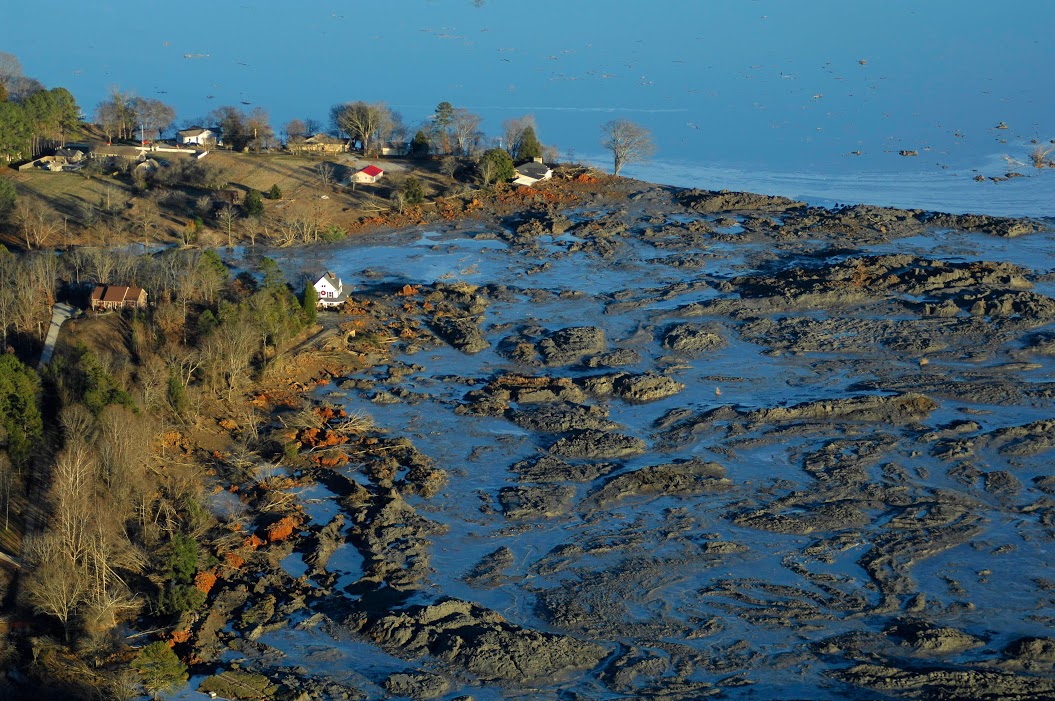As the plane circled over the 2008 coal-ash spill in Kingston, Tennessee, at Christmas, photographer Dot Griffith focused on the task: Take aerial shots of the damage unleashed by a failed dam at the Tennessee Valley Authority’s power plant on Dec. 22. More than a billion gallons of dark gray, toxic slurry had swept out of an 84-acre containment pond, rolled across the countryside and spread into the Emory River. “I wasn’t sure what we were going to see that day,” she says. “It was just so vast.”
The enormity of the spill didn’t hit Griffith until she scanned the final images, she says. Two photos in particular still linger in her mind, despite the passage of seven years: In one wide-frame photo, a Christmas wreath hangs on the door of a 2-story white farmhouse that lists to one side. The deserted home is dwarfed by the acres of sludge surrounding it. In another image, yellow bulldozers looked like kids’ toys set in a sea of dark mud, and the sludge darkens the river.
When coal is burned, it emits airborne toxins like sulfur dioxide and also leaves behind a concentrated residue containing such toxic substances as arsenic, mercury, chromium and selenium. Typically washed out into containment ponds, the ash is referred to in the utility industry as coal combustion residuals (CCRs). Some of it can be recycled, used as a lightweight component of bowling balls or concrete, for example. But most of it ends up stored in ponds that were built at least half a century ago, well before Congress passed the Clean Water Act in 1972 and long before state and federal regulators started requiring liners and other measures that prevent seepage into nearby streams, groundwater, rivers and bays.
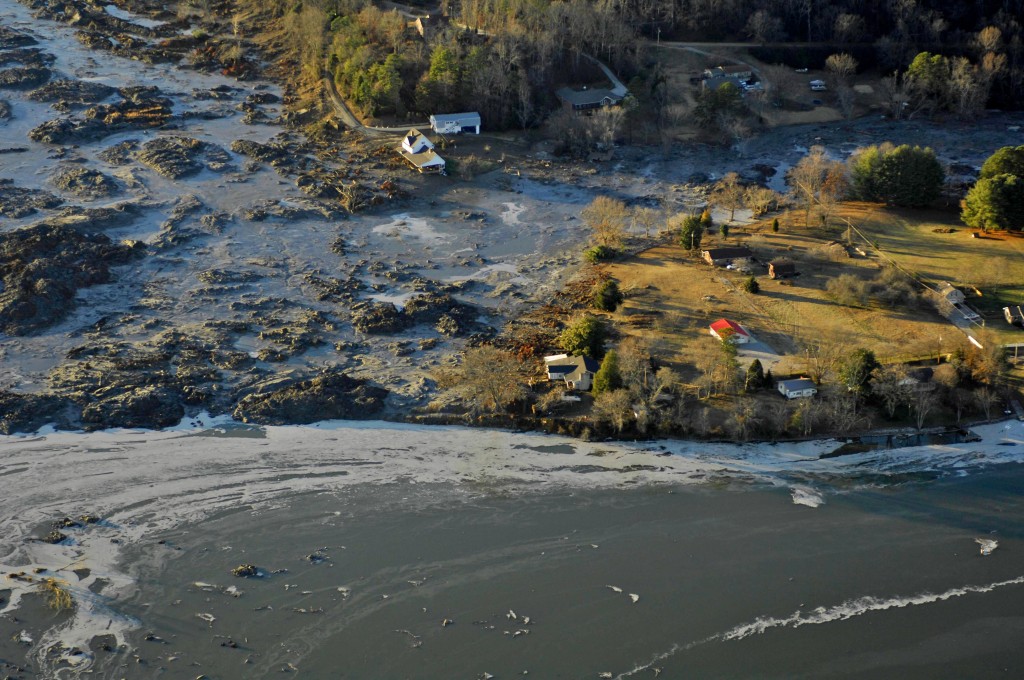
When the old dam at Kingston broke, sludge that was up to six feet deep blanketed nearly 400 acres of land. The force of the deluge knocked homes off their foundations and stopped a train on the tracks. The material poured across the land and into the Emory, spreading many miles downstream in a gray wash before most of it sunk to the bottom.
It was the worst CCR spill in the history of the United States. But in a way, Kingston helped move the Southeast away from getting most of its electricity by burning coal.
“It’s sad, but a big disaster tends to bring attention to an issue,” says Katie Hicks, assistant director of Clean Water for N.C.’s Asheville office. Kingston and the 2013 spill on the Dan River near Eden, North Carolina, demonstrate that CCRs should be stored in lined or otherwise encapsulated areas. The goal is keeping the concentrated toxins well away from waterways, groundwater and drinking sources, says Hicks.
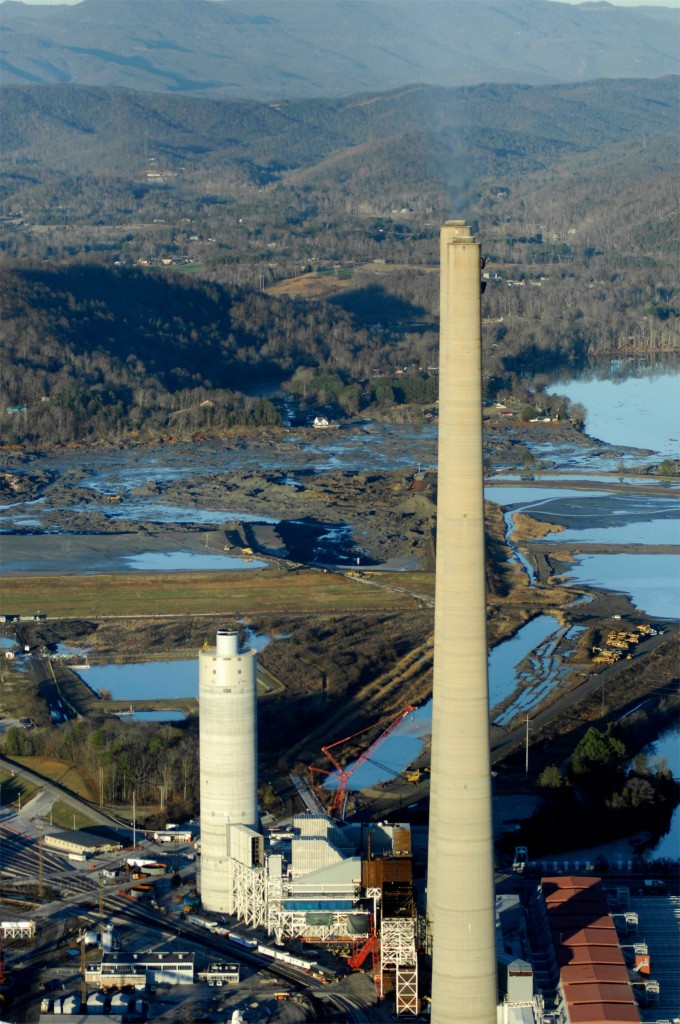
Industry leaders and policy makers have taken note. In the years since Kingston, hundreds of coal-fired plants have been closed across the country. Environmental groups have banded together, collecting data on contamination linked to coal ash, publishing their findings and filing lawsuits. The U.S. Environmental Protection Agency adopted stricter rules for coal ash. And in North Carolina in 2014, legislators passed the Coal Ash Management Act (CAMA).
The only such law in the Southeast, the legislation was spurred by the nation’s second largest coal-ash spill — the Dan River release of 24 million gallons of toxic sludge from a broken pipe at a shuttered Duke Energy power plant. CAMA requires Duke, the country’s largest utility, to fast-track pond cleanup and mitigate the problems caused by them, such as contaminated drinking wells.
Meanwhile, market forces have helped shift the tide as well. Global demand for coal has fallen sharply in the past few years. Four of the top-five coal producers have declared bankruptcy, most recently, Alpha Natural Resources in Virginia and Arch Coal Inc. in Missouri. Natural gas production and use is on the rise. And alternative, renewable energy sources like solar and wind power have become more cost effective.
“We’re on the cusp of a transition of how we get our energy in the Southeast,” says Kelly Martin, senior campaign representative for the Sierra Club in North Carolina and Florida. “Getting coal offline is big, … and clean energy is coming online. It’s increasingly cheaper to build solar plants and bring in wind power.”
But will the changes happen soon enough?
Ground Zero: Water Quality
While Griffith documented the disaster from the air, her longtime friend Donna Lisenby was on the ground at Kingston — or, more exactly, she was on the water. Now the Clean and Safe Energy Campaign Manager for the Waterkeeper Alliance, a New York-based international nonprofit, Lisenby paddled the Emory River in 2008. She surveyed the damage up close and cobbled together a research team.
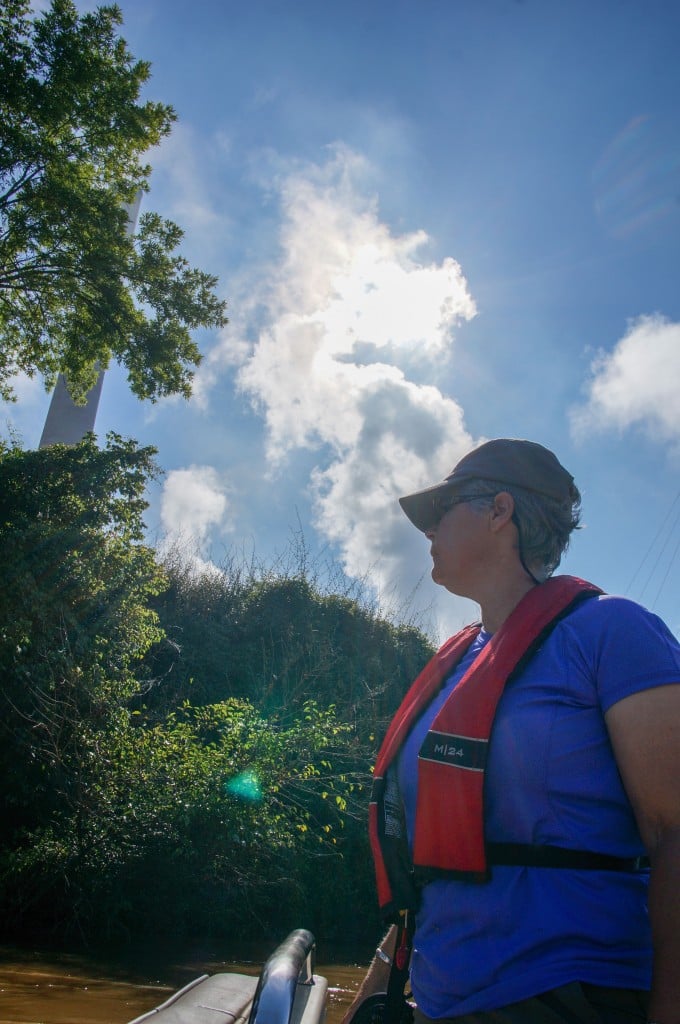
“I asked Dr. Shea Tuberty [of Appalachian State University] to test samples I collected, and he assembled a research team,” says Lisenby. “For the next two years, we investigated the short- and long-term impacts of the world’s largest coal-ash spill,” she says. “What we [confirmed] was that coal ash is full of heavy metals, and it impacts the wildlife and the water.”
The team gathered and published water-contamination results sooner than state and federal authorities, information that was critical in helping the public know “that coal ash was bad,” says Lisenby.
The work and the mission gained international attention, too, culminating in Clean Coal? Water Pollution at the Light Switch, a documentary directed by Jacques Cousteau’s granddaughter, Alexandra.
Two years later, fellow waterkeeper Hartwell Carson asked Lisenby to help research and document water pollution coming from coal-ash containment ponds in North Carolina, her home state. The duo led a multiday trip on the French Broad River, focused downstream of Duke Energy’s coal-ash containment ponds in Asheville. There was a visible discharge coming from at least one pipe, Lisenby says, and small streams nearby appeared to drain from the containment area into the river. “We pulled samples of water, fish and sediment,” she says.
The tests, run by a federally certified, Asheville lab, Pace Analytical Services, showed toxin levels that exceeded EPA or North Carolina regulations. The goal, says Lisenby, “was to inform the public what’s happening with their water.”
Test results
Mixed with water, coal ash contains a concentrated “suite of toxins” that can leach into nearby waterways and ground water, says Lisenby. The Kingston spill provided researchers with a chance to document and study its effects on water quality and aquatic life.
Two weeks after the Kingston disaster, Dr. Tuberty joined Lisenby on the Emory River, where dredging and other cleanup projects were underway. He sampled fish and other aquatic life. The section of the river near the power plant “is deep, [with fewer] species than further downriver,” says Tuberty. “But there should have been crawfish.”
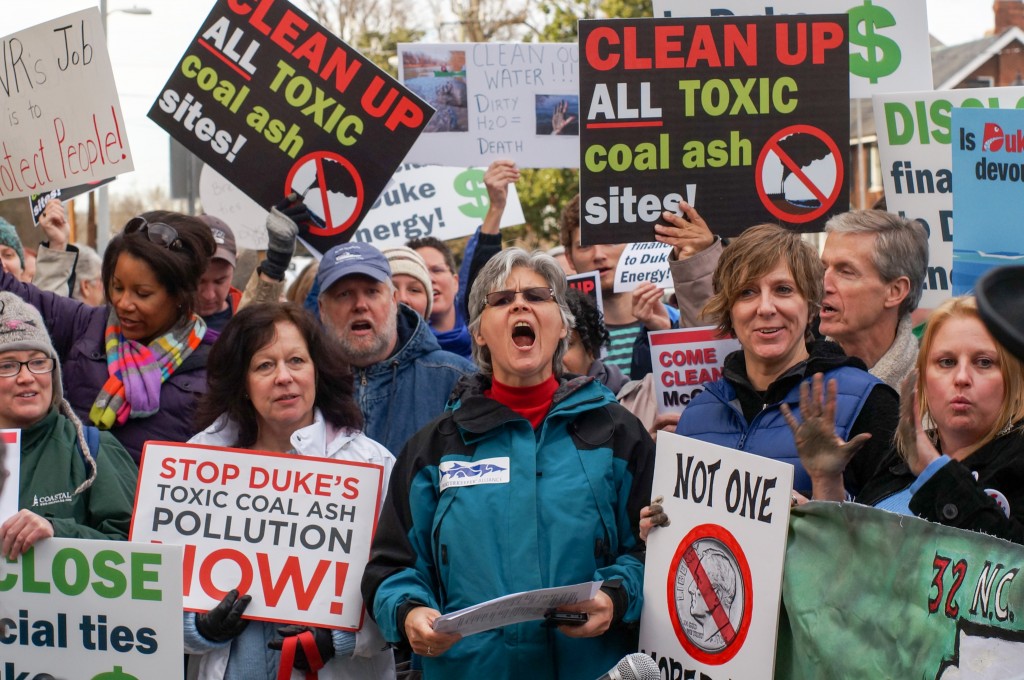
There weren’t. Not surprisingly, many species of invertebrates, fish and crawfish were buried by the sludge, he recalls. Sampled fish showed abrased gills and high levels of toxins, particularly selenium. “It’s a trace element that accumulates in the body, especially in the ovaries and in [fish] eggs,” says Tuberty.
High levels of selenium cause deformities in fish, he explains. Nicknamed “shellcrackers,” redeared sunfish nibble on bugs and eat fingernail clams, a river-bottom species that was particularly impacted by the settled coal ash sludge at Kingston, Tuberty says. In tests done in the years since the big spill, he’s found similar toxicities near coal-ash impoundments across North Carolina.
Tuberty’s team sampled quarterly at Kingston through 2010. “It proved really difficult to find crawfish even two years later,” he says. Toxicity in the fish, which move around and thus may not have been as harmed as less mobile or far-ranging aquatic life, peaked after about one and a half years, says Tuberty.
The Kingston spill provided valuable “source-in-time data, because the acute effects of the toxicity can be measured right away, and long-term effects can be tracked over time,” Tuberty continues. “These spill events are catastrophic enough to catch people’s attention [and] take the mask off of coal,” he says.
The effects of leached coal ash and sulphur dioxide emissions accumulate over time and can be found hundreds of miles away from a power plant, says Tuberty. He often goes fly-fishing on Wilson Creek below Grandfather Mountain in North Carolina’s high country. “It’s as natural an environment as you can get,” says Tuberty. For the last few years, he’s been taking North Carolina students there as part of the Summer Ventures in Science and Mathematics. Teams of kids do research projects and problem-solving exercises. At Wilson Creek, says Tuberty, participating students have documented acidic levels that are dangerously low for aquatic life, as well as high concentrations of sulphates — two markers of air pollution from coal-fired power plants, he says.
Although federal regulations and North Carolina’s 2002 Clean Smokestacks Act have helped reduce sulphur dioxide emissions in the region, contamination can still be found at such pristine sites as Wilson, he says. “How long will it take to recover?”
Proactive or Reactive?
After Kingston, the next turning point for regional environmentalists came via a lawsuit they filed against the state of North Carolina and Duke Energy about two years after Lisenby and Carson gathered data from the French Broad and drinking wells located near coal-ash ponds. “The rules are there,” says Julie Mayfield, co-director of Asheville-based nonprofit MountainTrue (formerly the Western North Carolina Alliance). The U.S. Clean Water Act requires states and utilities to clean up the source of contamination, she says.
To file the suit, MountainTrue joined forces with a host of regional waterkeeper organizations, as well as the Sierra Club and the Southern Environmental Law Center, but Mayfield credits Lisenby and Carson with doing the groundwork for the case. “We read [the law]. Our interpretation required Duke Energy to clean up the source,” says Mayfield. Lisenby and Carson’s work showed there’s “no question that wherever there are coal ash ponds, there’s … water pollution,” she says. “When the Dan River spill happened, no one could sweep it under the rug.”
The environmental coalition won in trial in 2013 but lost on appeal the next year, she reports. Duke and state officials argued that CAMA made the findings moot — the new law mandated the clean up called for in the suit, Mayfield says. Nonetheless, other environmental groups are applying similar tactics across the Southeast, the rest of the country and around the world, she says. “It’s going to take that kind of collaboration to keep moving forward.”
Duke Energy counters that it’s been proactive, not reactive. “We’ve been excavating ash from the Asheville plant since 2007 and providing it to the Asheville Regional Airport as part of a structural fill project at the taxiway,” says spokesperson Catherine Hope Butler. That fill site is lined and covered.
The company is also removing ash from its W.S. Lee and Riverbend plants, she continues. It has implemented a dam-safety program since Kingston and has plans “to begin excavation at Dan River and Sutton.” Duke is also continuing to research the beneficial uses of recycled CCRs, says Butler.
Years ago, fellow Duke spokesperson Lisa Parrish adds, the company “looked around the corner” at market changes and started closing coal-fired plants. “We’ve retired half of them since 2011,” she says. The company has also set in motion plans to switch to natural gas, including a new plant at Asheville in the next few years. “We’ve modernized our fleet [and] closed old plants, some built in the 1940s,” she continues.
Parrish adds that last April, Duke Energy’s Carolinas division produced more electricity from natural gas than coal — a first for the company.
Market forces have helped in the push away from coal, and natural gas does burn cleaner, but concern for the environment and public calls for alternative, non-fossil-fuel sources are also driving the changes, says Martin. Southern Co. — which owns utilities in Alabama, Georgia and Florida — plans to import wind power from the Midwest to the Southern states. Thanks to decreases in the cost of wind power, that’s a potentially cheaper option than running a fossil-fuel plant, she says. And more states than ever before allow residential solar installations to be financed in ways that defer the upfront costs; this lets more people take advantage of the clean power source, Martin continues.
“There’s a rapidly changing energy landscape in the Southeast,” she says. But Duke’s modernization plan “isn’t so modern; it doesn’t include enough renewables,” she says.
The Sierra Club would like to see more effort and emphasis on energy efficiency, says Emma Greenbaum, organizing representative for Beyond Coal in North Carolina. “These are things we know how to do,” she says. Duke Energy is the nation’s largest utility; if it were more proactive, other utilities would take notice and follow suit, she argues. “Duke could implement energy efficiency on a scale that would make a difference.”
Otherwise, “it’s an opportunity lost,” says Greenbaum.
The Bigger Picture
In addition to her photography work, Griffith has served on the board of Appalachian Voices, a regional nonprofit focused on environmental issues from one end of the Blue Ridge to the other. She’s traveled throughout the region, photographing mountaintop removal in Virginia and coal-ash contamination in Wilmington, N.C. Griffith has also traveled the world, often with Lisenby, to document the global effects of burning coal for fuel. Her work has given her a big-picture view.
“I’ve had a chance to see the mountains [in Virginia and West Virginia] that have been blown up and turned into mesas,” says Griffith. “In China, in particular, you see these huge [power plant] stacks with black soot coming out of them and all the people below, raising their gardens, despite what we know about the hazards,” she continues. “It’s so obvious that our planet is being spoiled.”
Amelia Shenstone, campaigns director for the Southern Alliance for Clean Energy, outlines some “good first steps” for changing the picture. “Gulf Power came to the table, ready to talk constructively about ways to clean up their [Florida] coal ash,” she says. The utility, a subsidiary of Southern Co., announced plans to move stored CCRs away from the Appalachicola River and the nearby bay, “where there’s a chance for catastrophic failure.” The area is famous for its fresh oysters.
Gulf Power’s proposal “is the first real coal-ash cleanup plan in Florida,” says Shenstone. “We hope all utilities in the South will take the most proactive steps to clean up their coal ash, prevent the next spill and prevent toxins from leaking into our groundwater and drinking water.”
About 40 percent of the electricity produced in the Southeast comes from burning coal, Shenstone continues. In America, coal use has been declining, while natural gas is rising. “Natural gas has its own problems, [and] overreliance on any one source is risky,” she says. SACE advocates for efficiency and renewable sources — “squeezing more out of our current generation of power sources and investing now in wind and solar.”
Clean energy and energy-efficiency initiatives can provide jobs; renewables are increasingly cheaper and competitive with fossil-fuel sources; and some utilities have started offering incentives that encourage customers to shift their use of electricity away from peak, high-load times of day, Shenstone explains.
“We are absolutely calling for some existing coal-fired power plants to be shut down, and we definitely should not build new ones. They’re the technology of yesterday, no matter how the industry spins it. If we’re going to move toward renewables, we need to start investing in them now.”
In the meantime, the EPA stopped short of declaring coal ash a hazardous waste, but it has put forth new water-quality guidelines and a Clean Power Plan for cutting “carbon pollution from existing power plants.” North Carolina legislators, however, have proposed a bill that could make it more difficult for public advocates and environmental groups to push the state for action on such problems as coal ash contamination, says Hicks. And an ongoing statewide evaluation of residential water wells near coal-ash ponds has indicated contamination in a majority of cases.
Hicks calls on the power of collaboration to keep “fighting this battle … over the next decade. Regular people can raise up their voices and say, ‘We want clean water and clean air.’”
[divider]Related Articles[/divider]
